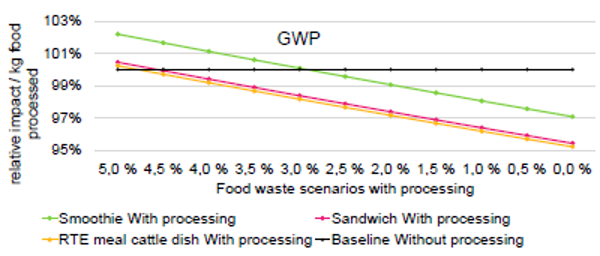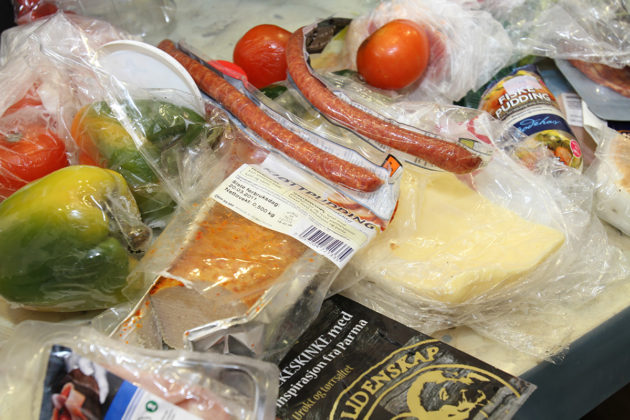What does the environment gain from us processing our food? We have used life cycle assessment methodology as a background to calculate this.
Life cycle analyses of food, what and how?
Life cycle assessment methodology calculates environmental impacts from farm to fork. This means that environmental emissions related to producing the food, preparing and packaging the food, distributing the food and selling the food from the store are included.
The role of food waste
One of the most important elements to take into account in an environmental analysis of foodstuffs is food waste. This is because food waste contributes to the unnecessary farming, preparation, packaging and sale of foodstuffs, which simply end up being thrown away. In other words, food waste is an environmental emission for things we just throw away. In addition, it creates more rubbish that we then have to process.
Meat and fish food waste
Food waste plays a particularly large role for foods such as meat and milk, especially beef and lamb. The environmental contribution to the foodstuff is usually very high, and producing meat that is simply thrown away will result in large additional environmental emissions.
There are types of meat that have lower production emissions such as chicken, fish and pork, and the impact food waste will have on total environmental emissions will be somewhat lower than for cattle, sheep and goats, but the principle is the same. The same applies to fish products. Large emissions are caused by food being thrown away, which also means that we don’t get to enjoy the discarded produce, there is simply more waste to process.

Fruit and vegetable food waste
Fruit and vegetables have much lower total life cycle emissions compared to meat. So, in theory, food waste plays less of a role for fruit and vegetables per percentage point of wastage. The challenging thing about fresh fruit and vegetables is that they often have a short shelf life, can quickly look less attractive and rapidly deteriorate. As a result, this leads to higher wastage levels. The accumulated amount of wastage is important here.
The principle is the same as for meat. Production, preparation, packaging and sales must be carried out for a much larger amount than what is eaten, and we waste resources or unnecessarily destroy a lot of nature.
The role of food processing from an environmental perspective
Food processing has two roles from an environmental perspective:
- Increases shelf life and marketability that can reduce food waste.
- Contributes to increased environmental emissions related to the foodstuff through energy use and materials for machinery.
Our analyses show that most processing technologies only entail a small additional environmental cost in relation to the rest of the life cycle of the food product.
However, there are a few exceptions, especially if food processing requires a relatively high amount of energy compared to the foodstuff’s total energy consumption combined with the use of fossil-based energy sources.
In general, the environmental impact associated with food waste is more significant than the environmental impact associated with food processing. As a rule of thumb, only a small reduction in food waste is needed to compensate for the increased environmental emissions directly caused by food processing.
However, it is important to remember that the higher the energy consumption and material consumption food processing contributes, the more food waste one must cut to compensate for emissions produced by the food processing.
Conclusion
Resource optimisation of food processing is relevant for foods that currently produce very little wastage.
However, there may be other places in the value chain that are more effective at reducing environmental impacts, such as phasing out fossil-based energy sources and replacing them with hydropower, increasing logistical efficiency, facilitating correct handling, applying the right packaging to the right product, and encouraging consumers to not throw their food away.
For foods that currently produce high levels of wastage, environmentally sound food processing significantly reduces the risk of wastage.
Challenges in environmental assessments of food processing technologies
The biggest challenge when calculating environmental impacts associated with changes in food waste is that there are many factors that cause wastage, not just the shelf life of the product.
It involves consumption habits, how produce is handled throughout the value chain, storage methods and the right packaging for the right product.
Therefore, it is only possible at the moment to project how much food waste a processing technology must reduce in order to compensate for its own emissions, and show trend lines for larger reductions in food waste.
| Title | Author(s) | Year | |
|---|---|---|---|
| Environmental footprint of high-pressure processing of Ready to Eat products (poster) | Mafalda, Silva; Svanes, Erik; Møller, Hanne; Valente, Clara | 2020 | Go to publication |
Food waste
- Food waste occurs at every stage of the food value chain.
- The environmental impact of food waste is greater if you as a consumer throw away 10% of your food than if 10% is thrown away by stores. This is because food stores have used energy and space storing the food items, and you as a consumer may have used a car or public transport to buy the item and perhaps also energy to prepare the food that is then thrown away. In addition, it will be the case that the food store also throws away some of the food that goes to your 10% of food waste. So there will be food waste in the store of your food waste.
- The link between shelf life and food waste is not entirely clear due to the fact that there are many more factors involved with food waste compared to shelf life. However, there is a consensus that increased shelf life has the potential to reduce food waste. This is because food items get more time to pass through the logistical and purchasing stages, and the items remain attractive over a long period of time.

